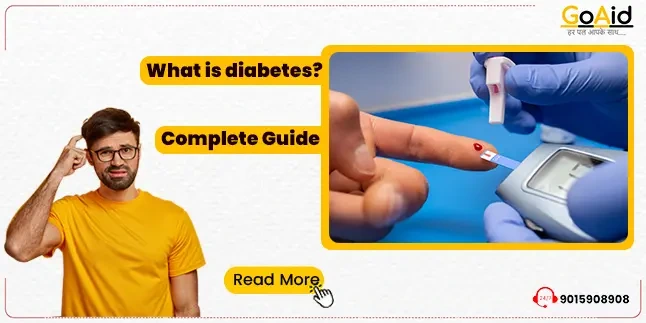Welcome to GoAid! Here, at GoAid Ambulance Services, we are helping people with ambulances on the ground and spreading awareness about the most Common / Famous diseases. Today, we have provided you with all the details about Diabetes. Diabetes is one of the most common and most famous diseases in this world. Also, prevention is also an absolute treatment of it.
According to the reports of the International Diabetes Federation, there are more than 537 Million People are affected by Diabetes. This is why its important to have a complete guide on Diabetes.
So, let’s start-
Basics about Diabetes
Diabetes is a chronic condition that affects how your body regulates blood sugar, also known as glucose. Glucose is a vital source of energy for cells in the body. Insulin, a hormone produced by the pancreas, helps glucose from food enter the cells to be used for energy.
Also Read:- Top 10 Dead Body Ambulance Service Providers in Delhi
Types of Diabetes
1. Type 1 Diabetes:
In type 1 diabetes, the immune system mistakenly attacks and destroys the insulin-producing beta cells in the pancreas. This results in little to no insulin production.
2. Type 2 Diabetes
Type 2 diabetes is characterized by insulin resistance, where the body’s cells don’t respond effectively to insulin. This leads to high blood sugar levels.
3. Gestational Diabetes
Gestational diabetes occurs during pregnancy when the body cannot produce enough insulin to meet the increased demands.
Symptoms of Diabetes
- Frequent urination
- Excessive thirst
- Increased hunger
- Unexplained weight loss (in type 1 diabetes)
- Fatigue
- Blurred vision
- Slow-healing sores or frequent infections
- Tingling or numbness in hands or feet
Also Read:- The Importance of ICU Ambulances in Critical Care Transportation
Diagnosis
Blood tests are used to diagnose diabetes. These may include fasting blood sugar tests, oral glucose tolerance tests, or A1C tests, which measure average blood sugar levels over the past two to three months.
Treatment
- Type 1 Diabetes: Requires lifelong insulin therapy through injections or an insulin pump, along with monitoring blood sugar levels and managing diet and exercise.
- Type 2 Diabetes: Treatment typically involves lifestyle modifications such as healthy eating, regular exercise, weight management, and, in some cases, oral medications or insulin therapy.
- Gestational Diabetes: Managed through dietary changes, exercise, and sometimes insulin therapy to keep blood sugar levels within a target range during pregnancy.
Complete Details about Diabetes – Complete Guide
We have guided you with the complete information about Diabetes below:
What is Diabetes?
Diabetes is a health condition where the body struggles to control blood sugar levels. There are different types: Type 1, Type 2, and gestational diabetes. Symptoms include thirst, frequent urination, and fatigue. Diagnosis involves blood tests.
Treatment includes medication, diet changes, and exercise. Without proper management, diabetes can lead to complications like heart disease and nerve damage. It’s essential to monitor blood sugar levels regularly and follow medical advice for a healthy life.
Different Types of Diabetes – Most Common Types of Diabetes
1. Type-1 Diabetes
- Definition: Type 1 diabetes, also known as insulin-dependent diabetes or juvenile diabetes, is an autoimmune condition where the body’s immune system mistakenly attacks and destroys the insulin-producing beta cells in the pancreas.
- Causes: The exact cause of type 1 diabetes is not fully understood, but it is believed to involve a combination of genetic predisposition and environmental triggers, such as viral infections or exposure to certain toxins.
- Onset: Type 1 diabetes often develops during childhood or adolescence, although it can occur at any age.
- Symptoms: Symptoms of type 1 diabetes typically develop rapidly and may include increased thirst, frequent urination, extreme hunger, unexplained weight loss, fatigue, and blurred vision.
- Treatment: People with type 1 diabetes require lifelong insulin therapy to survive. Insulin is usually administered through injections or an insulin pump. Along with insulin therapy, managing blood sugar levels through monitoring, healthy eating, regular physical activity, and proper medical care is essential for optimal health.
2. Type-2 Diabetes
- Definition: Type 2 diabetes, also known as non-insulin-dependent diabetes, is a metabolic disorder characterized by insulin resistance, where the body’s cells become resistant to the effects of insulin, or by decreased insulin production by the pancreas.
- Causes: The primary risk factors for type 2 diabetes include obesity, sedentary lifestyle, unhealthy diet, genetic predisposition, aging, and ethnicity.
- Onset: Type 2 diabetes typically develops gradually over time, often in adulthood, although it is increasingly being diagnosed in children and adolescents due to rising obesity rates.
- Symptoms: Symptoms of type 2 diabetes may develop slowly and may include increased thirst, frequent urination, increased hunger, unexplained weight loss, fatigue, blurred vision, and slow-healing sores or frequent infections.
- Treatment: Treatment for type 2 diabetes may involve lifestyle modifications such as healthy eating, regular physical activity, weight management, and, in some cases, oral medications or insulin therapy. Management aims to control blood sugar levels, prevent complications, and improve overall health.
3. Gestational Diabetes
- Definition: Gestational diabetes is a form of diabetes that develops during pregnancy, usually in the second or third trimester, when the body cannot produce enough insulin to meet the increased demands.
- Causes: Hormonal changes during pregnancy can lead to insulin resistance, particularly in women with risk factors such as obesity or a family history of diabetes.
- Onset: Gestational diabetes typically resolves after childbirth, but women who have had gestational diabetes have an increased risk of developing type 2 diabetes later in life.
- Symptoms: Gestational diabetes often has no symptoms or mild symptoms that may go unnoticed. It is usually detected through routine prenatal screening tests.
- Treatment: Treatment for gestational diabetes involves dietary changes, regular physical activity, and, in some cases, insulin therapy to keep blood sugar levels within a target range during pregnancy. Proper management is essential for the health of both the mother and the baby.
4. Prediabetes
- Definition: Prediabetes is a condition where blood sugar levels are higher than normal but not high enough to be diagnosed as type 2 diabetes. It is considered an intermediate stage between normal blood sugar levels and diabetes.
- Causes: Prediabetes occurs when the body becomes resistant to the effects of insulin or when the pancreas does not produce enough insulin to maintain normal blood sugar levels. Risk factors for prediabetes include obesity, sedentary lifestyle, unhealthy diet, family history of diabetes, and aging.
- Onset: Prediabetes often precedes the development of type 2 diabetes and may progress to diabetes if left untreated. However, with lifestyle modifications, such as weight loss, healthy eating, and regular physical activity, prediabetes can often be reversed.
- Symptoms: Prediabetes may not cause any symptoms, or symptoms may be subtle and go unnoticed. However, individuals with prediabetes are at increased risk of developing type 2 diabetes, as well as other health conditions such as heart disease and stroke.
- Diagnosis: Prediabetes is diagnosed through blood tests that measure fasting blood sugar levels, oral glucose tolerance tests, or A1C tests. Blood sugar levels that are higher than normal but not high enough for a diabetes diagnosis indicate prediabetes.
- Treatment: Treatment for prediabetes focuses on lifestyle modifications to reduce the risk of progression to type 2 diabetes and improve overall health. This includes weight loss, adopting a healthy diet low in sugar and refined carbohydrates, increasing physical activity, and quitting smoking if applicable. Some individuals may also benefit from medications such as metformin to lower their risk of developing diabetes.
Symptoms
We have added the Most Common Symptoms of Diabetes:
1. Frequent Urination (Polyuria)
- Increased need to urinate, especially at night.
- Excess glucose in the blood pulls fluids from tissues, leading to increased urination.
2. Excessive Thirst (Polydipsia)
- Feeling extremely thirsty even after drinking fluids.
- Caused by dehydration due to frequent urination.
3. Increased Hunger (Polyphagia)
- Constant feelings of hunger, even after eating.
- Cells aren’t getting enough glucose for energy, leading to increased appetite.
4. Unexplained Weight Loss
- Losing weight without trying, particularly common in type 1 diabetes.
- The body breaks down muscle and fat for energy when cells don’t get enough glucose.
5. Fatigue
- Feeling tired and lethargic, even after getting enough rest.
- Cells aren’t able to use glucose efficiently for energy production.
6. Blurred Vision
- Vision becomes blurry due to changes in fluid levels in the eyes caused by high blood sugar.
7. Slow-Healing Sores and Infections
- Wounds take longer to heal and infections are more common.
- High blood sugar impairs the immune system’s ability to fight infections and heal wounds.
8. Tingling or Numbness in Hands and Feet (Neuropathy)
- Nerve damage caused by prolonged high blood sugar levels.
- Can lead to tingling, numbness, or pain, particularly in the hands and feet.
Causes & Risk Factors of Diabetes
We have added a comprehensive details about the causes and risk factors of diabetes duabelow:
Causes of Diabetes:
Type 1 Diabetes
- Autoimmune Destruction: Type 1 diabetes is primarily caused by an autoimmune reaction where the body’s immune system mistakenly attacks and destroys the insulin-producing beta cells in the pancreas.
- Genetic Predisposition: While the exact cause is unknown, genetic factors play a significant role in predisposing individuals to type 1 diabetes. Certain genetic variations increase the likelihood of developing the condition.
Type 2 Diabetes
- Insulin Resistance: Type 2 diabetes develops when the body becomes resistant to the effects of insulin or when the pancreas fails to produce enough insulin to overcome this resistance. This results in elevated blood sugar levels.
- Obesity and Sedentary Lifestyle: Being overweight or obese, especially with excess abdominal fat, significantly increases the risk of developing type 2 diabetes. Lack of physical activity and sedentary behavior further contribute to insulin resistance.
- Genetic Factors: Family history and genetics play a significant role in the development of type 2 diabetes. Having a parent or sibling with type 2 diabetes increases the risk of developing the condition.
Gestational Diabetes
- Hormonal Changes: During pregnancy, hormonal changes can lead to insulin resistance, particularly in the later stages of pregnancy when the placenta produces hormones that impair insulin action.
- Obesity and Age: Being overweight or obese before pregnancy and older maternal age are risk factors for gestational diabetes.
Common Risk Factors for Diabetes:
1. Family History
Having a close relative, such as a parent or sibling, with diabetes increases the risk of developing the condition.
2. Obesity and Overweight
Excess body weight, especially abdominal fat, is a significant risk factor for type 2 diabetes. Fat cells release chemicals that can disrupt insulin action and glucose metabolism.
3. Physical Inactivity
Lack of regular physical activity and sedentary behavior contribute to insulin resistance and increase the risk of type 2 diabetes.
4. Unhealthy Diet
Consuming a diet high in processed foods, sugary beverages, saturated fats, and refined carbohydrates contributes to obesity and insulin resistance, increasing the risk of type 2 diabetes.
5. Age
The risk of type 2 diabetes increases with age, particularly after the age of 45. This is partly due to decreased physical activity, muscle mass, and metabolic rate as people age.
6. Ethnicity and Race
Certain ethnic groups, including African Americans, Hispanics, Native Americans, Asian Americans, and Pacific Islanders, have a higher risk of developing type 2 diabetes compared to Caucasians.
7. Gestational Diabetes History
Women who have previously had gestational diabetes or have given birth to a baby weighing over 9 pounds are at increased risk of developing type 2 diabetes later in life.
8. Polycystic Ovary Syndrome (PCOS)
Women with PCOS, a hormonal disorder characterized by irregular periods and excess male hormone levels, have an increased risk of insulin resistance and type 2 diabetes.
Complications of Diabetes
1. Short-Term Complications:
a. Hypoglycemia (Low Blood Sugar)
- Definition: Hypoglycemia occurs when blood sugar levels drop below normal levels (typically below 70 mg/dL).
- Causes: Taking too much insulin, skipping meals, or exercising vigorously without adjusting insulin or carbohydrate intake can lead to hypoglycemia.
- Symptoms: Symptoms may include shakiness, sweating, irritability, confusion, fast heartbeat, and in severe cases, loss of consciousness or seizures.
- Treatment: Consuming fast-acting carbohydrates such as glucose tablets, fruit juice, or candy to raise blood sugar levels quickly. Glucagon injections may be needed for severe hypoglycemia.
b. Hyperglycemia (High Blood Sugar)
- Definition: Hyperglycemia occurs when blood sugar levels rise above the target range (typically above 180 mg/dL).
- Causes: Skipping insulin doses, consuming excessive carbohydrates, illness, stress, or inadequate physical activity can lead to hyperglycemia.
- Symptoms: Symptoms may include increased thirst, frequent urination, fatigue, blurred vision, and in severe cases, diabetic ketoacidosis (DKA).
- Treatment: Insulin therapy, drinking plenty of water to stay hydrated, monitoring blood sugar levels closely, and seeking medical attention if blood sugar levels remain high.
c. Diabetic Ketoacidosis (DKA)
- Definition: DKA is a life-threatening complication of diabetes characterized by high blood sugar levels, ketone buildup in the blood, and acidosis.
- Causes: DKA is commonly triggered by illness, infection, insufficient insulin dosage, or neglecting insulin therapy.
- Symptoms: Symptoms may include excessive thirst, frequent urination, nausea, vomiting, abdominal pain, fruity-scented breath, confusion, and eventually loss of consciousness.
- Treatment: Immediate medical attention is required. Treatment includes intravenous fluids to rehydrate, insulin therapy to lower blood sugar and ketone levels, and correction of electrolyte imbalances.
2. Long-Term Complications:
a. Cardiovascular Disease
- Definition: Diabetes significantly increases the risk of developing heart disease, including coronary artery disease, heart attack, stroke, and peripheral artery disease.
- Causes: High blood sugar levels, insulin resistance, high blood pressure, abnormal cholesterol levels, and obesity contribute to cardiovascular complications.
- Prevention/Treatment: Managing blood sugar levels, controlling blood pressure and cholesterol, maintaining a healthy weight, regular exercise, and avoiding smoking can help prevent cardiovascular complications.
b. Nerve Damage (Neuropathy)
- Definition: Diabetes can damage nerves throughout the body, leading to various forms of neuropathy, including peripheral neuropathy (affecting hands and feet), autonomic neuropathy (affecting internal organs), and focal neuropathy (affecting specific nerves).
- Symptoms: Symptoms may include numbness, tingling, burning sensations, weakness, pain, digestive issues, sexual dysfunction, and urinary problems.
- Prevention/Treatment: Tight blood sugar control, pain management medications, physical therapy, and lifestyle modifications can help manage neuropathic symptoms.
c. Kidney Disease (Nephropathy)
- Definition: Diabetes is a leading cause of kidney disease (diabetic nephropathy), which can lead to kidney failure requiring dialysis or kidney transplantation.
- Causes: High blood sugar levels and high blood pressure damage the kidneys’ filtering units (glomeruli) over time.
- Prevention/Treatment: Tight blood sugar and blood pressure control, medications to protect kidney function (ACE inhibitors or ARBs), and lifestyle changes can slow the progression of kidney disease.
d. Eye Damage (Retinopathy)
- Definition: Diabetes can cause damage to the blood vessels in the retina (diabetic retinopathy), leading to vision problems and even blindness.
- Causes: High blood sugar levels and high blood pressure damage the small blood vessels in the retina, causing leakage, swelling, and abnormal blood vessel growth.
- Prevention/Treatment: Regular eye exams, tight blood sugar and blood pressure control, laser therapy, injections, or surgery may be necessary to manage retinopathy and prevent vision loss.
e. Foot Problems
- Definition: Diabetes increases the risk of foot complications such as diabetic neuropathy, poor circulation, foot ulcers, and infections.
- Causes: Nerve damage and reduced blood flow to the feet increase the risk of injuries, infections, and slow wound healing.
- Prevention/Treatment: Daily foot care, wearing appropriate footwear, regular foot exams, managing blood sugar and blood pressure levels, and seeking prompt medical attention for any foot issues can help prevent complications.
Diagnosis of Diabetes
This is how the Diabetes gets disgnosed:
1. Screening and Diagnosis
a. Symptoms Evaluation
Diabetes may present with symptoms such as increased thirst, frequent urination, unexplained weight loss, fatigue, blurred vision, and slow wound healing. If individuals experience these symptoms, they should seek medical evaluation.
b. Blood Tests
- Fasting Plasma Glucose (FPG) Test: A blood test after an overnight fast measures blood sugar levels. A fasting plasma glucose level of 126 mg/dL or higher on two separate occasions indicates diabetes.
- Oral Glucose Tolerance Test (OGTT): After fasting, individuals consume a sugary drink, and blood sugar levels are tested periodically over two hours. A blood glucose level of 200 mg/dL or higher two hours after consuming the drink indicates diabetes.
- A1C Test: This blood test measures average blood sugar levels over the past two to three months. An A1C level of 6.5% or higher indicates diabetes.
c. Random Plasma Glucose Test
This test measures blood sugar levels at any time of the day, regardless of when the individual last ate. A blood glucose level of 200 mg/dL or higher along with symptoms of diabetes indicates diabetes.
2. Additional Diagnostic Considerations
a. Gestational Diabetes Screening
Pregnant women may undergo glucose tolerance testing between 24 and 28 weeks of pregnancy to screen for gestational diabetes.
b. Prediabetes Diagnosis
Prediabetes is diagnosed based on blood sugar levels that are higher than normal but not high enough for a diabetes diagnosis. Fasting plasma glucose levels between 100 and 125 mg/dL, oral glucose tolerance test results between 140 and 199 mg/dL, or an A1C level between 5.7% and 6.4% indicate prediabetes.
3. Confirmation of Diagnosis
To confirm a diagnosis of diabetes, healthcare providers typically repeat abnormal test results on a different day to rule out temporary spikes in blood sugar levels.
4. Monitoring and Follow-Up
- Individuals diagnosed with diabetes require regular monitoring of blood sugar levels to assess control and adjust treatment as needed.
- Regular follow-up appointments with healthcare providers are essential for ongoing management of diabetes and prevention of complications.
- Diabetes education and support resources can help individuals understand their condition, manage their treatment plan effectively, and make lifestyle adjustments to improve their health outcomes.
Top 10 Tips to Prevent Diabetes
If you are willing to prevent the diabetes from you, then you should follow these tips in your life:
1. Maintain a Healthy Weight
- Aim to achieve and maintain a healthy weight through a balanced diet and regular physical activity. Being overweight or obese increases the risk of developing type 2 diabetes.
2. Adopt a Healthy Diet
- Focus on consuming a variety of nutrient-rich foods, including fruits, vegetables, whole grains, lean proteins, and healthy fats.
- Limit intake of sugary beverages, processed foods, refined carbohydrates, and foods high in saturated and trans fats.
3. Be Physically Active
- Engage in regular physical activity for at least 150 minutes per week, or about 30 minutes most days of the week.
- Incorporate a combination of aerobic exercises (such as walking, jogging, swimming) and strength training exercises into your routine.
4. Monitor Your Blood Sugar Levels
- If you have prediabetes or other risk factors for diabetes, monitor your blood sugar levels regularly as advised by your healthcare provider.
- Early detection and intervention can help prevent or delay the onset of type 2 diabetes.
5. Avoid Sedentary Behavior
- Limit sedentary activities such as prolonged sitting or screen time.
- Take breaks to stand, stretch, and move throughout the day, especially if you have a desk job or spend long hours sitting.
6. Drink Water and Limit Sugary Beverages
- Stay hydrated by drinking plenty of water throughout the day.
- Limit consumption of sugary beverages such as soda, fruit juices, energy drinks, and sweetened teas, as they can contribute to weight gain and increase the risk of diabetes.
7. Quit Smoking
- If you smoke, quit smoking to reduce the risk of developing type 2 diabetes and other chronic health conditions.
- Seek support from healthcare professionals, counseling services, or smoking cessation programs to help you quit successfully.
8. Manage Stress
- Practice stress-reducing techniques such as deep breathing, meditation, yoga, or mindfulness to manage stress effectively.
- Chronic stress can contribute to unhealthy lifestyle behaviors and increase the risk of developing diabetes.
9. Get Adequate Sleep
- Aim for 7-9 hours of quality sleep per night.
- Poor sleep quality or insufficient sleep may increase the risk of obesity, insulin resistance, and type 2 diabetes.
10. Get Regular Check-ups
- Schedule regular health check-ups with your healthcare provider to monitor your overall health, including blood sugar levels, blood pressure, cholesterol levels, and weight.
- Early detection of risk factors or prediabetes allows for timely intervention and preventive measures.
Treatment of Diabetes
The treatment of diabetes aims to manage blood sugar levels effectively, prevent complications, and improve overall health and well-being. The treatment approach varies depending on the type of diabetes and individual factors such as age, lifestyle, and medical history. Here’s an overview of the treatment options for diabetes:
1. Type 1 Diabetes:
a. Insulin Therapy
- Individuals with type 1 diabetes require lifelong insulin therapy to replace the insulin their bodies are unable to produce.
- Insulin may be administered through multiple daily injections or insulin pump therapy, which delivers insulin continuously throughout the day.
b. Blood Sugar Monitoring
Regular monitoring of blood sugar levels is essential for adjusting insulin doses, preventing hypoglycemia and hyperglycemia, and optimizing glycemic control.
c. Healthy Lifestyle
Adopting a healthy diet, engaging in regular physical activity, maintaining a healthy weight, and managing stress are essential for managing type 1 diabetes effectively.
2. Type 2 Diabetes:
a. Lifestyle Modifications
- Healthy eating: Focus on a balanced diet rich in fruits, vegetables, whole grains, lean proteins, and healthy fats. Limit intake of sugary foods and beverages, refined carbohydrates, and saturated fats.
- Regular exercise: Engage in moderate-intensity aerobic activity (such as brisk walking, cycling) and strength training exercises most days of the week.
- Weight management: Achieve and maintain a healthy weight through diet, exercise, and behavior modification.
b. Oral Medications
Oral medications may be prescribed to lower blood sugar levels, improve insulin sensitivity, or reduce glucose production by the liver. Examples include metformin, sulfonylureas, DPP-4 inhibitors, SGLT2 inhibitors, and GLP-1 receptor agonists.
c. Injectable Medications
Some individuals with type 2 diabetes may require injectable medications, such as GLP-1 receptor agonists or insulin, to help control blood sugar levels.
3. Gestational Diabetes:
a. Blood Sugar Monitoring
Regular monitoring of blood sugar levels is crucial during pregnancy to ensure blood sugar levels are within the target range and to prevent complications for both the mother and the baby.
b. Healthy Lifestyle
Adopting a healthy diet, engaging in regular physical activity, and maintaining a healthy weight are essential for managing gestational diabetes and promoting a healthy pregnancy.
c. Insulin Therapy
Insulin therapy may be necessary for some women with gestational diabetes if blood sugar levels cannot be controlled through diet and exercise alone.
Additional Considerations for Diabetes Management:
a. Education and Support
Diabetes education programs provide valuable information and support for individuals living with diabetes, helping them understand their condition, manage their treatment plan, and make lifestyle adjustments.
b. Regular Medical Check-ups
Regular follow-up appointments with healthcare providers are essential for monitoring blood sugar levels, assessing treatment effectiveness, and preventing or managing complications.
c. Monitoring and Managing Complications
Individuals with diabetes should be screened regularly for complications such as heart disease, kidney disease, nerve damage, and eye problems. Early detection and management of complications are crucial for preventing long-term health issues.
Other Disease that can generate with Diabetes
Diabetes can increase the risk of developing various other health conditions and complications. Here are some common diseases and complications associated with diabetes:
1. Cardiovascular Diseases
- Heart Disease: Diabetes increases the risk of coronary artery disease, heart attack, and heart failure. High blood sugar levels, insulin resistance, and other metabolic factors contribute to the development of heart disease.
- Stroke: Diabetes is a major risk factor for stroke, which occurs when the blood supply to the brain is disrupted, leading to brain damage and neurological deficits.
2. Kidney Disease (Nephropathy)
Diabetes is a leading cause of kidney disease, known as diabetic nephropathy. High blood sugar levels and high blood pressure damage the kidneys’ filtering units (glomeruli), leading to decreased kidney function and eventual kidney failure.
3. Nerve Damage (Neuropathy)
- Peripheral Neuropathy: Diabetes can cause nerve damage, particularly in the extremities (hands and feet), leading to symptoms such as numbness, tingling, burning sensations, and pain.
- Autonomic Neuropathy: Diabetes can affect the nerves that control involuntary bodily functions, leading to digestive issues, urinary problems, sexual dysfunction, and cardiovascular abnormalities.
4. Eye Damage (Retinopathy)
Diabetes increases the risk of eye diseases such as diabetic retinopathy, diabetic macular edema, cataracts, and glaucoma. High blood sugar levels damage the blood vessels in the retina, leading to vision problems and potential vision loss if left untreated.
5. Foot Complications
Diabetes can cause foot problems such as diabetic neuropathy, poor circulation (peripheral artery disease), foot ulcers, and infections. Nerve damage and reduced blood flow to the feet increase the risk of injuries, infections, and slow wound healing.
6. Skin Conditions
Diabetes increases the risk of various skin problems, including bacterial and fungal infections, itching, dry skin, and slow wound healing. High blood sugar levels provide an ideal environment for bacterial and fungal growth.
7. Dental Issues
Diabetes is associated with an increased risk of dental problems such as gum disease (periodontitis), tooth decay (cavities), oral infections, and delayed wound healing following dental procedures.
8. Mental Health Disorders
Diabetes is linked to an increased risk of mental health disorders such as depression, anxiety, and diabetes distress. The psychological impact of living with a chronic condition, as well as the physiological effects of diabetes on the brain, can contribute to mental health issues.
9. Complications during Pregnancy
- Gestational Diabetes: Diabetes that develops during pregnancy can increase the risk of complications for both the mother and the baby, including macrosomia (large birth weight), birth injuries, preeclampsia, and future risk of type 2 diabetes for the mother and child.
Myths about Diabetes
Despite the widespread prevalence of diabetes, there are several myths and misconceptions surrounding the condition. It’s essential to debunk these myths to promote accurate understanding and effective management of diabetes. Here are some common myths about diabetes:
Myth 1 Diabetes is caused by eating too much sugar.
Reality: While consuming sugary foods and beverages can contribute to weight gain and increase the risk of type 2 diabetes, the condition is caused by a combination of genetic, lifestyle, and environmental factors. Type 1 diabetes is an autoimmune condition, and type 2 diabetes is primarily influenced by factors such as obesity, sedentary lifestyle, and genetics.
Myth 2 People with diabetes can’t eat carbohydrates.
Reality: Carbohydrates are an essential macronutrient and a significant source of energy for the body. People with diabetes can and should include carbohydrates in their diet, but they need to monitor portion sizes, choose complex carbohydrates (such as whole grains, fruits, and vegetables), and balance carbohydrate intake with insulin or medication.
Myth 3 Diabetes only affects older adults.
Reality: While type 2 diabetes is more common in older adults, it can affect individuals of any age, including children and adolescents. Type 1 diabetes can develop at any age, although it is often diagnosed in childhood or adolescence.
Myth 4 Diabetes is not a serious disease.
Reality: Diabetes is a chronic condition that requires lifelong management. If left untreated or poorly managed, diabetes can lead to serious health complications, including heart disease, stroke, kidney failure, nerve damage, vision loss, and lower limb amputations.
Myth 5 People with diabetes should only eat special “diabetic” foods.
Reality: There is no need for special “diabetic” foods. People with diabetes can enjoy a varied and balanced diet that includes a variety of foods. The key is to focus on portion control, healthy food choices, and moderation.
Myth 6 Insulin causes weight gain.
Reality: Insulin therapy is essential for many people with diabetes, especially those with type 1 diabetes or advanced type 2 diabetes. While insulin can contribute to weight gain due to its anabolic effects, weight gain is often a result of improved blood sugar control and better overall health management.
Myth 7 Only overweight or obese people get diabetes.
Reality: While being overweight or obese is a significant risk factor for type 2 diabetes, thin or normal-weight individuals can also develop the condition. Genetics, family history, ethnicity, and lifestyle factors all play a role in diabetes risk.
Myth 8 Diabetes can be cured with natural remedies or alternative therapies.
Reality: While lifestyle modifications such as healthy eating, regular exercise, and weight management can help manage diabetes effectively, there is no cure for diabetes. Alternative therapies and natural remedies may complement conventional treatment but should not replace medical management.
Myth 9 Diabetes is contagious.
Reality: Diabetes is not a contagious disease. It cannot be spread through casual contact, such as shaking hands, sharing utensils, or being in close proximity to someone with diabetes.
Myth 10 People with diabetes can’t lead a normal life.
Reality: With proper management, people with diabetes can lead full, active, and healthy lives. It may require some adjustments and vigilance, such as monitoring blood sugar levels, taking medications as prescribed, and making healthy lifestyle choices, but diabetes should not define or limit a person’s life.
Also Read: Oxygen Ambulance vs. Regular Ambulance: Key Differences
Top-10 Hospitals for Diabetes in India
These are the top 10 Hospitals in India that can help you with your Diabetes with best of Proficiency:
1. All India Institute of Medical Sciences (AIIMS), Delhi:
AIIMS in Delhi is a prestigious medical institution known for its comprehensive diabetes care services, including specialized clinics, research, and education programs.
2. Fortis C-Doc Hospital, Delhi:
Fortis C-Doc Hospital is a leading healthcare facility dedicated to diabetes care, offering state-of-the-art diagnostic and treatment services, including diabetes prevention programs and lifestyle management.
3. Apollo Hospitals, Chennai:
Apollo Hospitals in Chennai is renowned for its multidisciplinary approach to diabetes management, with specialized clinics, diabetes educators, dietitians, and advanced treatment options.
4. Dr. Mohan’s Diabetes Specialities Centre, Chennai:
Dr. Mohan’s Diabetes Specialities Centre is a premier institution focused exclusively on diabetes care, offering comprehensive services, including diagnostic tests, consultations, and personalized treatment plans.
5. Manipal Hospitals, Bangalore:
Manipal Hospitals in Bangalore has a dedicated diabetes center equipped with advanced technology and a team of experienced endocrinologists, diabetologists, and support staff to provide holistic diabetes care.
6. Max Super Specialty Hospital, Delhi:
Max Super Specialty Hospital is known for its specialized diabetes clinics, research initiatives, and patient-centered care approach, offering a range of services from diagnosis to advanced treatment options.
7. Narayana Health (formerly Narayana Hrudayalaya), Bangalore:
Narayana Health is a leading healthcare provider with a specialized diabetes institute offering comprehensive care, education programs, and research initiatives for diabetes management.
8. Medanta – The Medicity, Gurgaon:
Medanta is a multi-specialty hospital with a dedicated endocrinology department offering advanced diagnostics, personalized treatment plans, and lifestyle management programs for diabetes patients.
9. Columbia Asia Hospital, Bangalore:
Columbia Asia Hospital is known for its comprehensive diabetes care services, including diagnostic facilities, specialized clinics, and a team of skilled healthcare professionals focused on diabetes management.
10. KIMS Hospital, Hyderabad:
Krishna Institute of Medical Sciences (KIMS) Hospital in Hyderabad provides specialized diabetes care services, including diagnostics, consultations, treatment options, and lifestyle management programs.
10 Interesting Facts about Diabetes
You might be surprised to know these interesting facts about Diabetes:
- Global Reach: A staggering number of people live with diabetes. The International Diabetes Federation estimates 537 million adults (aged 20-79) have it globally.
- Silent Threat: One in five people with diabetes are unaware they have it. This highlights the importance of regular checkups and awareness of potential symptoms.
- Not Just Sugar Blues: While diet plays a role, type 2 diabetes isn’t solely caused by excessive sugar intake. Genetics and lifestyle factors also significantly contribute.
- Double Trouble: The number of adults diagnosed with diabetes has more than doubled in the past 20 years in some countries, reflecting trends towards obesity and inactivity.
- Predominant Type: Type 2 diabetes makes up roughly 90-95% of all diagnosed cases. It often develops later in life and can be managed through lifestyle changes and medication.
- Sweet Treats Aren’t Off Limits: People with diabetes can still enjoy sweets, but portion control and mindful eating are key. A healthy diet and proper management are crucial.
- More Than Blood Sugar: Diabetes can affect various parts of the body. It’s a risk factor for heart disease, stroke, kidney problems, nerve damage, and vision issues.
- Gestational Surprise: Having gestational diabetes during pregnancy doesn’t guarantee your baby will develop diabetes, but it does increase the risk.
- Emotional Impact: The diagnosis and management of diabetes can bring emotional challenges. Support systems and education are important for well-being.
- Manageable Condition: With proper treatment and lifestyle adjustments, people with diabetes can lead long and fulfilling lives.
Conclusion – Complete Guide to Diabetes
In conclusion, understanding diabetes is vital for effective management and prevention of its complications. With its multifaceted nature, diabetes demands a holistic approach encompassing lifestyle modifications, regular monitoring, and medical interventions tailored to individual needs. Embracing a balanced diet, maintaining a healthy weight, engaging in regular exercise, and adhering to prescribed treatments are crucial.
Equally important is debunking prevalent myths and misconceptions surrounding diabetes to foster accurate understanding and support. By promoting awareness, access to quality healthcare, and fostering a supportive environment, we can empower individuals with diabetes to lead fulfilling lives while effectively managing their condition and minimizing its impact on their overall well-being.
FAQs related to Complete Guide to Diabetes
Q-1: What is diabetes?
Answer. Diabetes is a chronic condition characterized by high blood sugar levels due to inadequate insulin production or the body’s inability to use insulin effectively.
Q-2: What are the basics of diabetes?
Answer. The basics of diabetes include understanding its types, symptoms, causes, risk factors, complications, diagnosis, prevention tips, and treatment options.
Q-3: What are the common symptoms of diabetes?
Answer. Common symptoms of diabetes include increased thirst, frequent urination, unexplained weight loss, fatigue, blurred vision, and slow wound healing.
Q-4: What causes diabetes?
Answer. Diabetes is caused by a combination of genetic, lifestyle, and environmental factors, such as obesity, sedentary lifestyle, unhealthy diet, and genetic predisposition.
Q-5: What are the risk factors for diabetes?
Answer. Risk factors for diabetes include obesity, family history of diabetes, sedentary lifestyle, unhealthy diet, age, ethnicity, and gestational diabetes during pregnancy.
Q-6: What complications can arise from diabetes?
Answer. Diabetes complications include cardiovascular disease, kidney disease, nerve damage, eye damage, foot complications, skin conditions, dental issues, and mental health disorders.
Q-7: How is diabetes diagnosed?
Answer. Diabetes is diagnosed through blood tests that measure fasting plasma glucose, oral glucose tolerance, A1C levels, and random plasma glucose levels.
Q-8: What are the top-10 tips to prevent diabetes?
Answer. Prevention tips for diabetes include maintaining a healthy weight, adopting a healthy diet, engaging in regular physical activity, monitoring blood sugar levels, avoiding sedentary behavior, and quitting smoking.
Q-9: What are the different types of diabetes?
Answer. The different types of diabetes include type 1 diabetes, type 2 diabetes, gestational diabetes, and prediabetes.
Q-10: Is there a vaccine for diabetes?
Answer. Currently, there is no vaccine available for diabetes. However, research is ongoing to develop preventive strategies and treatments for the condition.
Q-11: What are other health issues that can arise due to diabetes?
Answer. Other health issues associated with diabetes include cardiovascular diseases, kidney disease, nerve damage, eye damage, foot complications, skin conditions, dental issues, and mental health disorders.
Q-12: What are common myths about diabetes?
Answer. Common myths about diabetes include misconceptions about its causes, dietary restrictions, treatment options, and lifestyle limitations.
Q-13: How can myths about diabetes be debunked?
Answer. Myths about diabetes can be debunked through education, awareness campaigns, access to reliable information, and open dialogue with healthcare professionals.
Q-14: What are some interesting facts about diabetes?
Answer. Interesting facts about diabetes include its global prevalence, impact on various populations, advancements in treatment options, and ongoing research efforts.
Q-15: What are the top-10 hospitals in India for diabetes care?
Answer. Top hospitals in India for diabetes care include AIIMS Delhi, Fortis C-Doc Hospital Delhi, Apollo Hospitals Chennai, Dr. Mohan’s Diabetes Specialities Centre Chennai, Manipal Hospitals Bangalore, Max Super Specialty Hospital Delhi, Narayana Health Bangalore, Medanta Gurgaon, Columbia Asia Hospital Bangalore, and KIMS Hospital Hyderabad.
Q-16: Is there a cure for diabetes?
Answer. Currently, there is no cure for diabetes. However, with proper management and lifestyle modifications, individuals with diabetes can lead healthy and fulfilling lives.
Q-17: Can diabetes be prevented?
Answer. While type 1 diabetes cannot be prevented, type 2 diabetes and gestational diabetes can often be prevented or delayed through lifestyle modifications such as healthy eating, regular exercise, and weight management.
Q-18: Can diabetes be reversed?
Answer. Type 2 diabetes may be reversible through intensive lifestyle interventions, such as weight loss, healthy eating, and regular physical activity. However, it requires sustained effort and ongoing management.
Q-19: What role does genetics play in diabetes?
Answer. Genetics plays a significant role in diabetes risk, as individuals with a family history of diabetes are at higher risk of developing the condition. However, lifestyle factors also play a crucial role in diabetes prevention and management.
Q-20: Can diabetes affect pregnancy?
Answer. Yes, diabetes can affect pregnancy, leading to gestational diabetes, which requires careful monitoring and management to prevent complications for both the mother and the baby.
Q-21: How can diabetes affect mental health?
Answer. Diabetes can impact mental health by increasing the risk of depression, anxiety, and diabetes distress due to the challenges of managing a chronic condition and potential complications.
Q-22: Are there any dietary restrictions for diabetes?
Answer. While there are no specific dietary restrictions for diabetes, individuals are advised to limit their intake of sugary foods and beverages, refined carbohydrates, and saturated fats, and focus on consuming a balanced diet rich in fruits, vegetables, whole grains, lean proteins, and healthy fats.
Q-23: What role does exercise play in diabetes management?
Answer. Exercise plays a crucial role in diabetes management by improving insulin sensitivity, lowering blood sugar levels, managing weight, reducing cardiovascular risk, and promoting overall health and well-being.
Q-24: Can diabetes lead to vision problems?
Answer. Yes, diabetes can lead to vision problems such as diabetic retinopathy, diabetic macular edema, cataracts, and glaucoma, which can affect vision and lead to blindness if left untreated.
Q-25: How can diabetes be managed effectively?
Answer. Diabetes can be managed effectively through a combination of medication, lifestyle modifications, regular monitoring of blood sugar levels,

















